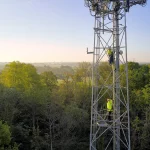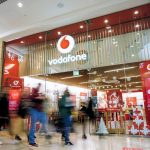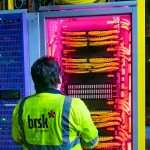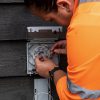Ofcom Sees Average UK Fixed Broadband ISP Speeds Hit 80Mbps

Ofcom has today published somewhat of a preview for their annual study into fixed line UK broadband ISP speeds, which reveals that the average (mean) download speed of home connections has risen by 25.3% since last year to 80.2Mbps. Upload speeds have also jumped by 54% to 21.6Mbps.
By the looks of it the delays caused by the Government’s recent COVID-19 lockdown seem to have pushed Ofcom’s full annual report back to the autumn, which means that we only get a handful of interesting statistics in today’s short update on the same dataset.
As usual this is based off data gathered during November 2020 via custom modified routers from SamKnows, which were installed in around 2,945 UK homes (3,075 units in the ISP panel). This method of testing is extremely accurate but the limited sample size does force their report to focus on only the most common broadband technologies, packages and ISPs.
Advertisement
The current active panel also excludes customers on packages with headline speeds of 2Mbps and less, because of the current low market share of these connections (less than 0.1% of the total).
The Results
Only 8% of consumers were found to have average speeds of less than 10Mbps and 78% are on “superfast” or better packages with download rates above 30Mbps (just 5% of connections deliver an average of 300Mbps or more). Naturally, old copper ADSL broadband lines had the lowest average speed of 10.3Mbps.
Ofcom also reported that there has been a 54% increase in the mean average upload speed of UK residential broadband services since the last report, which is largely down to the take-up and growing coverage of faster technologies (FTTP etc.).

Advertisement
Finally, while average speeds in rural areas remain lower than in towns and cities, more than half (60%) of rural households could still get speeds of over 30Mbps during peak hours of the day, compared to almost three quarters (74%) of urban households.
Mark is a professional technology writer, IT consultant and computer engineer from Dorset (England), he also founded ISPreview in 1999 and enjoys analysing the latest telecoms and broadband developments. Find me on X (Twitter), Mastodon, Facebook, BlueSky, Threads.net and Linkedin.
« Ultrafast O2 5G Network Now Live in 183 UK Towns and Cities
Scottish Government Look to Improve Broadband Mapping Tech »






















































Maybe a stupid question, but is there a link to the ofcom page described in this article? I couldn’t see any links except for ones to the main homepage. Have noticed this with a few articles I’ve read.
This is such a misleading measure! It would be much more useful to know how many people can actually get 80Mbp, rather than an average which is skewed by a few extremely fast connections. Each gigabit connection puts 99 times more into this average than each 10 Mbps connection.
As an example, if there were just 2 households, 1 getting 1000Mbps and 1 getting 10Mbps, the average would be 505Mbps! Sounds great, but half the households are only getting 10Mbps.
Then if one more 1000Mbps connection is added, the average jumps to 670Mbps, Ofcom say “isn’t this great”, but I might still be on 10Mbps.
Come on Ofcom – let’s have some meaningful data.
And for good measure we’ll exclude the slowest connections lest they interfere with the figures ?
“The current active panel also excludes customers on packages with headline speeds of 2Mbps and less, because of the current low market share of these connections (less than 0.1% of the total).”
I suspect they won’t show available speeds because the data would make them look bad and/or require too much work to acquire it.
All they need do is exclude all the ADSL connections, and the overall average would increase significantly. Job done! (and much cheaper than actually providing superfast broadband to everyone).
My thoughts exactly. Its OFCOM trying its best at a PR exercise, probably because they’re a toothless quango and feeling unappreciated by the consumers they allow telco’s to walk all over?
Perhaps this would be resolved by obtaining a copy of the raw data? (i.e. a list of the speeds – nothing personally identifying!)
It appears that the root of the problem here is using the mean and not the median, which would be easily solved with the raw data.
FWIW, Ofcom provides the base data. If you take the median, it comes out around 61.5Mbit/s download…so skewed but not as much as you might imagine. Around 27% had an average (mean) of more than 80Mbit/s. Interestingly in an environment where Ofcom refers to gigafast services, I couldn’t find any instantaneous test result above 940Mbit/s, or a customer averaging more than 934Mbit/s.
Replying to adslmax further down, my reading of the tests are that they’re based on actual data download, not sync speed.
I use to get 74mbps now 69 but it’s fast enough for me for my new rate of £19 a month from Vodafone
I don’t know, I grew up in darkest hilly rural mid Wales. Most of my friends have at least 40meg connections in the villages, if not they installed 4g external antennas for a minimum of 20meg.
Heck, a few villages have had FTTP installed where there is a rural primary school, council building or NHS site with 1km.
I do like a good ‘Average’ in a headline or advertising.
> I couldn’t find any instantaneous test result above 940Mbit/s
That’s because speedtest results measure only the TCP payload content of a data stream.
If you pack a gigabit ethernet link with 1500-byte MTU frames, then by the time you’ve taken off the TCP, IP and ethernet headers, you’re left with 942Mbps theoretical maximum payload throughput.
This puts the availability of >100 Mbit/s at just over 66%.
https://labs.thinkbroadband.com/local/
@Damien
Correct. Your sync speed with overheads and whatnot will mean you not see that speed.
The average UK download and upload speeds being higher than any widely-available non-VM service doesn’t pass the smell test to me, would be interested to see the methodology.
I yearn to become average in OFCOMs eyes.
Join the club!
In this kind of report tracking a median rather than average would make more sense
That wouldn’t provide the results they were after. Got to make some politicians look like BT is actually progressing in some way.
Haha lucky to get 13mbs on a good day
The link to the report https://www.ofcom.org.uk/research-and-data/telecoms-research/broadband-research/broadband-speeds/uk-home-broadband-performance-nov-2020
That’s misleading! On 80000 sync rate by Openreach FTTC but a real true speed throughput are 73-74Meg not 80Meg.
STOP MISLEADING OFCOM
For someone who spends most of their day on blogs and forums, I wonder if that’s misleading the DWP?
Why? FTTC isn’t capable of 80Mbps.
Usually sync speeds are used to determine the ‘goodness’ of a FTTC circuit.
Speed tests tend to measure the throughput, hence will be lower due to overheads.
FTTC relies on radio signals propagated down twisty wires, so the closer you are to the DSLAM, the faster sync (and hence speed) you will get.Huawei actually say FTTC is recommended to be < 1000m between subscriber and DSLAM.
Bad design of the UK network has resulted in subscribers getting a poor service due to the distance, in some cases they would be better off on ADSL.
FTTC can exceed 80Mbs sync, but you would need to be very close to the DSLAM, with low interference/cross talk.
G-FAST uses higher frequencies, but shorter distances before the sync speed drops off.
Radio signals are subject to interference/crosstalk, so for example if you were with 10m of the DSLAM, and I had a device capable of providing wideband interference I could reduce your speed dramatically, by reducing your signal to noise and causing packet resends.
I find it very amusing that people expect the 'speed test' to equal the sync speed.
Even with FTTP there are overheads but less issues with interference/crosstalk.
Okay HAM001, say you’re 100-200ft from the cabinet with overhead telegraph pole twisted pair thats over 50 years old……what’s the best you could hope for realistically?
Certainly nothing “super” or “fast”.
@Buggerlugz
No sure I understand your reply, but G-Fast, VDSL, ADSL all use radio technologies, not fibre.
In all three cases the laws of physics apply, further away, more attenuation, with the added issues of interference and crosstalk.
Add into that line issues such as metal poles, trees touching the lines, bad connections which can impact the speed.
Searching the internet will show you the theoretical speeds for each technology.
Suppliers set the speed lower than the theoretical maximum to ensure a suitable signal to noise and to improve the usable distance.
It would have been far better to have missed out VDSL & G-FAST, putting the effort in FTTP.
FTTC at 80 capped speed (seen one connection that was 95/30 capable, but locked to 80/20) is quite rare have to be really close to the cab
OFCOM, the pillar of fairness and uncompetitive practices in the telecoms market publishing a totally misleading and unsubstantiated pile of bull. Who’d have thought?
Still, makes BT look better when the vast majority in the UK have to “make do” with substandard “Pretend fibre” FTTC (which will never get those speeds quoted).
Superfast Broadband less than 30Mbs
https://www.whatdotheyknow.com/request/superfast_broadband_less_than_30
Let’s face it in 2021 even 30mbps isn’t ‘superfast’. They should ditch these pointless and confusing terms (and fibre broadband when it’s fttc too)
Meh. I get 75 Meg on a BT openreach 80 Meg connection and I’m happy with it. It occasionally has a wobble (more often the router tbh), but perfectly decent.
I tried virgin in 3 separate postcodes in Cardiff before that. Honest to god, smoke signals emitted manually in morse code would have been faster at 8pm. Probably didn’t help we had 5-6 people in the property at any one time..
500Mbps would be more realistic in 2021 IMHO. OFCOM need to stop pandering to BT and put a stop to all the “fast” nonsense and make them specify the actual speeds you will be getting.
Actual expected speeds at sign up time have been provided for years. We lost the ‘up to’ advertising a while ago.
Not sure what the 500 Mbit/s refers to but over half the UK could subscribe to 500 Mbit/s and over 40% gigabit.
Actual subscription to 300 Mbit+ is less than 5% of the country, less than 1 in 10 of those able to subscribe to 300 Mbit+ actually does.
re
500Mbps would be more realistic in 2021 IMHO. OFCOM need to stop pandering to BT and put a stop to all the “fast” nonsense and make them specify the actual speeds you will be getting.
What ‘speed’ are you referring to?
For example you could go round the M25 at 150 mph, if there was no other traffic, however in the real world this is not the case.
FTTP will give you, if you pay for it just below 1Gps, however in the real world, the fibre is aggregated, ie you do not have a unique
fibre connection to the exchange and its back haul,.
Let assume you do have a unique fibre connection to the exchange, then you may be limited to the constraints of the back haul.
Lets assume this is not a problem, , but then the server you are requesting may be being accessed by other users, how annoying,
so you will not get the service you desire.
You may then decide 500Mbs is not what you really need, the lower profile may be a better financial option.
You need to look at this with a holistic view.
Exactly 500mbps should be a minimum requirement for every ISP provider otherwise it feels like a jungle.
If you wanna pay £50+ maybe. I’d love a gigabit symmetric connection but I don’t feel the need to pay more than about £20 because I don’t require anything more than 1080p Netflix-iplayer, photo backup, zoom and the odd OS update and of course an occasional game of age of empires.
But who knows, maybe I’m not a typical user.
I’m in a full fibre estate. Most of the people here subscribe to 80 Mbit or lower.
Why should they have less choice?
My sync of 80 gives me a max of 74.4 down. 21.2 up. But it’s mostly 67/18 I see.
I’m on Superfast2 from Vodafone – they advertise 63 down, 18 up.
Best service I’ve had from any home ISP!
Is there any data available on the speeds that are available – I presume the figures are based on speed tests, but I would imagine the vast majority of people don’t necessarily purchase the fastest speed available to them for the sake of it, unlike geeks like myself.
This isn’t too far away, Dave – https://labs.thinkbroadband.com/local/
Thanks Mr T, interesting stuff
2.3mb down on a good day, 0.3mb upload.
And no intention to upgrade the exchange only line we have.
If you live rurally, you can see if you can claim vouchers towards gigabit broadband.
Link: https://gigabitvoucher.culture.gov.uk/
FTTC, G.fast have five profiles set by DLM
IP Profile are 96.59% from sync rate 329.99 = 318.73 (downstream only) for G.fast (throughput speed 314)
IP Profile are 96.59% from sync rate 159.99 = 154.53 (downstream only) for G.fast (throughput speed 150)
IP Profile are 96.70% from sync rate 79.99 = 77.35 (downstream only) for VDSL (throughput speed 73)
IP Profile are 96.70% from sync rate 39.99 = 38.67 (downstream only) for VDSL (throughput speed 34)
INP Rein 0 = Re-tx low better higher throughput speed
INP Rein 1 = Re-tx high lower throughput speed usually at 91-92% from the ip profile